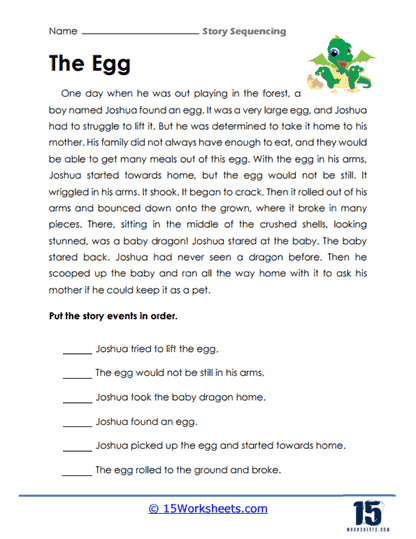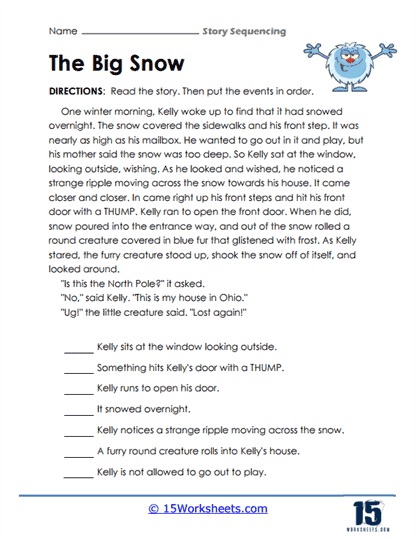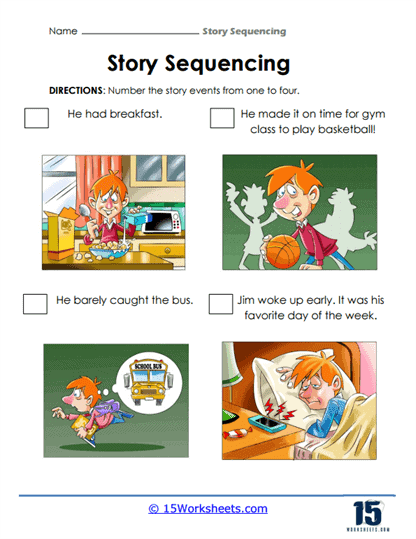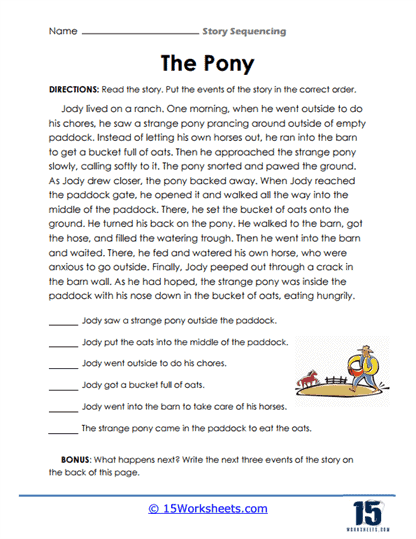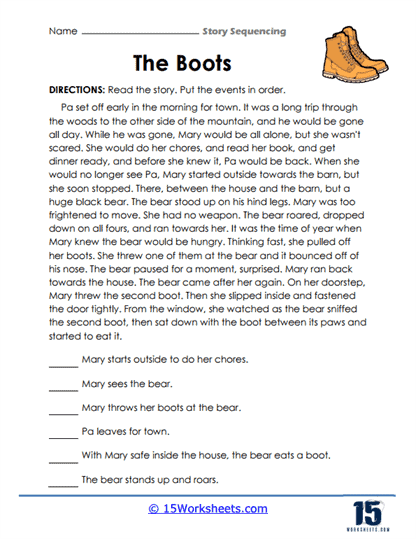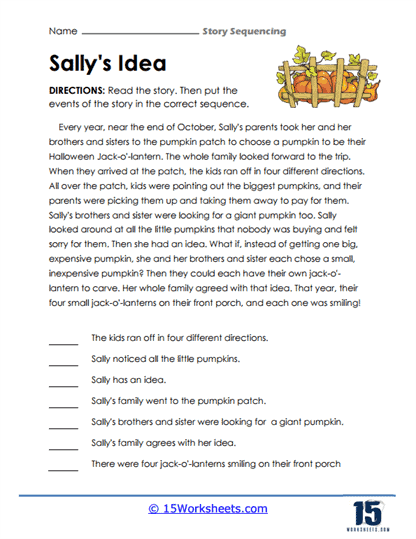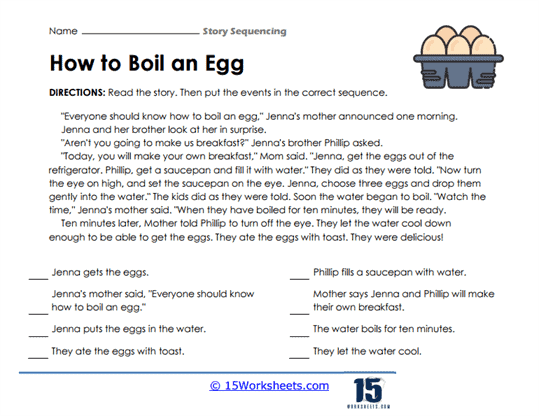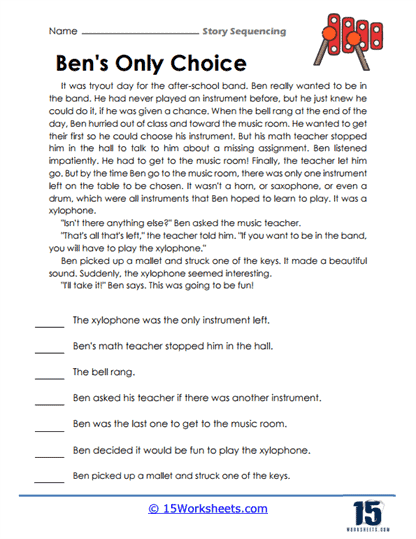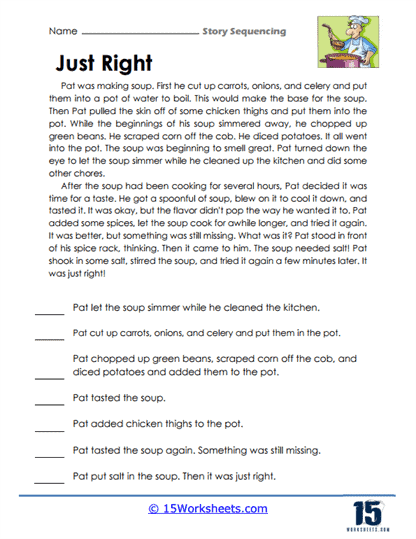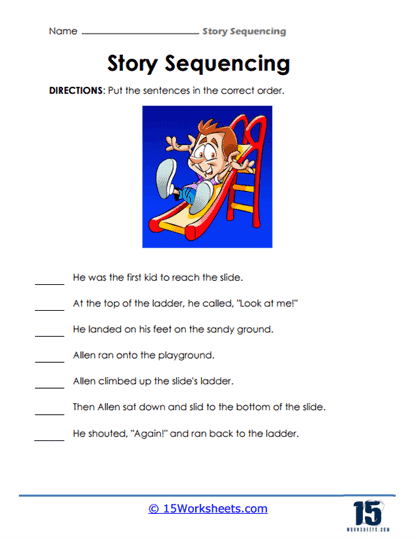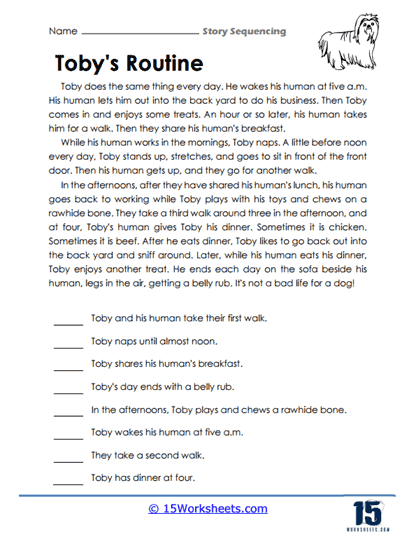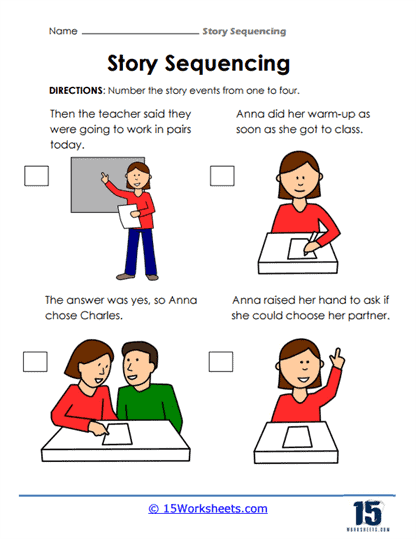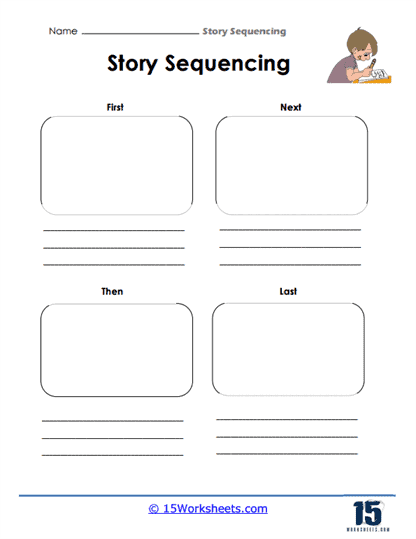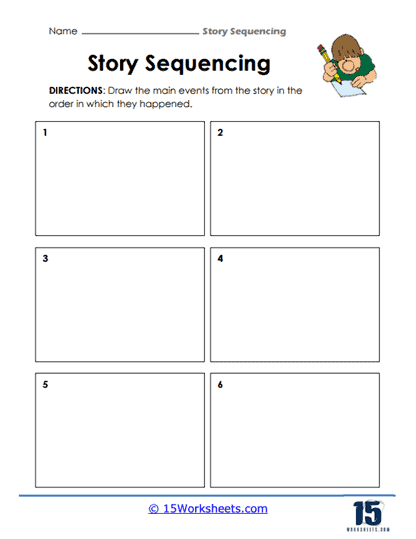Story Sequencing Worksheets
All About These 15 Worksheets
These worksheets can help students understand the structure and flow of a narrative by organizing events in the correct order. These worksheets focus on the ability to recognize the logical progression of a story-from the beginning to the middle and the end-and are essential for developing reading comprehension and critical thinking skills. Sequencing, or the ability to arrange story events chronologically, is a fundamental aspect of narrative understanding. By practicing this skill, students not only improve their grasp of storytelling but also enhance their ability to follow instructions, solve problems, and think critically about how events unfold in various texts.
These worksheets are typically aimed at younger students who are building foundational reading skills but are also useful for older students or English language learners. They teach students how to identify key events in a story, understand cause-and-effect relationships, and recognize how actions and decisions lead to specific outcomes. The ability to sequence events correctly is crucial for developing a strong understanding of both fiction and nonfiction texts, as it allows students to make sense of the material they are reading. As students advance, these worksheets help them with more complex tasks, such as summarizing plots, writing coherent narratives, and analyzing texts in a more structured way.
Improving Reading and Language Arts Skills
Story sequencing worksheets play a significant role in improving a variety of reading and language arts skills. They help strengthen reading comprehension. When students practice sequencing events in a story, they must actively engage with the text, identifying important details and understanding how these details fit together. For example, if a student is reading a story about a character’s adventure, they must determine what happened first (the character set out on the journey), what happened next (they encountered a challenge), and how the story concluded (the character overcame the challenge). This process encourages careful reading and ensures that students are not simply skimming the text but are fully comprehending the story’s structure.
Another key benefit of story sequencing worksheets is that they improve students’ critical thinking and organizational skills. By arranging events in the correct order, students learn how to organize their thoughts and recognize patterns within a text. This skill is transferable to other areas of learning, such as writing, where students must logically sequence their ideas to create clear, coherent essays or stories. Additionally, the ability to sequence events teaches students about cause and effect, which is a crucial component of narrative analysis and everyday problem-solving. For example, understanding that a character’s actions lead to certain consequences helps students comprehend not only the plot but also the motivations and development of characters.
These worksheets help develop language arts skills like summarizing, writing, and storytelling. When students work on story sequencing, they are often asked to summarize the events in their own words. This practice reinforces their ability to paraphrase and condense information-essential skills for writing book reports, essays, or summaries of nonfiction texts. As students progress, they can apply the sequencing skills they’ve learned to their own writing projects. Being able to structure their stories with a clear beginning, middle, and end is crucial for producing cohesive and engaging narratives. By understanding the natural flow of stories through sequencing, students also improve their narrative writing abilities, learning how to build suspense, resolve conflicts, and create satisfying conclusions in their own creative work.
Types of Exercises
The worksheets come in various formats and difficulty levels, depending on the age and skill level of the students. One common exercise involves cutting and pasting story events. In these activities, students are given a series of events from a story, often out of order, and they must cut them out and paste them in the correct sequence. For example, in a story about a day at the beach, the worksheet might provide events like “packed our bags,” “played in the sand,” and “went home.” Students are tasked with placing these events in the correct chronological order. This hands-on activity helps younger learners visualize the flow of a story and makes the learning process interactive and engaging.
Another type of exercise involves multiple-choice questions where students are given a short passage followed by questions that ask them to select the correct order of events. For instance, after reading a passage about a camping trip, students might be asked, “What happened first?” or “Which event occurred last?” These questions test both their comprehension of the text and their ability to recall details in the proper order. This type of exercise not only reinforces sequencing skills but also improves students’ attention to detail and memory, as they must carefully track the order of events to answer correctly.
For more advanced students, story sequencing worksheets might include paragraph reordering exercises. In these activities, students are given a passage broken down into separate paragraphs, and they must arrange the paragraphs in the correct sequence to create a cohesive narrative. This type of exercise is particularly beneficial for older students because it requires a deeper understanding of narrative structure and logical flow. For example, in a passage about a scientific experiment, students must determine the proper order of the steps involved-such as the hypothesis, experiment, and conclusion-mirroring the process they would use when writing a lab report. This helps build essential writing and analytical skills, as students learn how to structure information logically.
In addition to these activities, some worksheets may involve picture sequencing for younger learners or those who struggle with reading. In these exercises, students are provided with a series of pictures that represent different events in a story, and they must arrange the pictures in the correct order. For instance, a worksheet might show images of a plant growing from a seed, first sprouting, then developing leaves, and finally becoming a full-grown plant. Students arrange these images to reflect the natural progression of the plant’s growth. This type of visual exercise is excellent for early readers or visual learners, as it reinforces the concept of sequencing without relying heavily on text.
Another valuable exercise often found in story sequencing worksheets involves writing prompts where students must create their own stories by arranging a series of events. They might be given a list of actions like “finds a map,” “goes on a treasure hunt,” and “discovers the treasure,” and they must write a story that incorporates these events in a logical sequence. This type of activity encourages creativity while also reinforcing the importance of a clear and organized narrative structure.
Teaching Story Sequencing Skills
Helping students improve their story sequencing skills over time requires a structured, yet engaging approach that gradually builds their confidence and understanding of how events in a story unfold. Story sequencing is a critical skill in developing reading comprehension and narrative understanding, and teachers can use a variety of methods to make learning fun and effective. By employing interactive activities, visual aids, and consistent practice, teachers can foster a deep understanding of story structure in their students.
The first step in teaching story sequencing is to start with simple, familiar stories. For younger students or those new to the concept, it’s important to use stories they already know, such as classic fairy tales or favorite picture books. By starting with narratives they recognize, students can focus more on understanding the sequence of events without struggling to comprehend new content. A teacher might begin by reading a short story aloud and then asking students to recount the events. Afterward, the teacher can present pictures or simple sentences that describe the key events in the story, asking students to arrange them in the correct order. This familiar context makes it easier for students to grasp the basic idea of beginning, middle, and end.
As students become comfortable with this process, the teacher can introduce more interactive and hands-on activities to make story sequencing more engaging. One fun approach is to use cut-and-paste exercises, where students physically manipulate story elements. For example, after reading a story, students can be given a set of pictures or sentences representing different events in the narrative. They then cut these out and paste them in the correct sequence. This tactile activity is particularly effective for younger students, as it reinforces the concept of sequencing through physical movement. It also adds a playful element to the lesson, making the learning process enjoyable and less like a traditional worksheet task.
Another engaging method is to turn story sequencing into a group or class activity. Teachers can create story cards that feature different parts of a narrative, and then give each student one of these cards. The students must work together to determine the correct order of events by discussing the story and rearranging themselves into the correct sequence. This not only helps improve sequencing skills but also encourages teamwork, communication, and listening. For instance, the teacher could read a story about a day at the park, then distribute cards that say things like “arrived at the park,” “played on the swings,” “ate a snack,” and “went home.” Students would have to cooperate to figure out who holds the card for the first event and where the rest of the actions should go.
To deepen understanding, teachers can also incorporate visual storytelling as part of their approach. Picture sequencing activities are a great way to engage visual learners or younger students who may struggle with text-heavy exercises. For example, teachers can show a series of images that depict a sequence of events—such as a child waking up, getting dressed, eating breakfast, and heading to school—and ask students to place the images in the correct order. Teachers can then discuss with students why certain events must come before others, encouraging logical reasoning and reflection on cause-and-effect relationships within stories. This method is particularly useful for building foundational sequencing skills without overwhelming students with too much text.
As students become more advanced, teachers can introduce more complex stories and integrate story sequencing with other language arts skills, such as writing and summarizing. One effective way to do this is by asking students to rearrange paragraphs from a story into the correct order. This activity requires students to read more critically, looking for clues within the text to determine the proper sequence. For instance, they might look for transition words like “first,” “next,” and “finally” or context clues about time and place to figure out how the events fit together. This more sophisticated exercise challenges students to apply their sequencing skills to longer, more complex narratives and encourages deeper engagement with the text.
In addition to arranging stories written by others, teachers can help students improve their sequencing skills by having them create their own stories. Creative writing is a powerful tool for reinforcing sequencing, as it requires students to think about how to structure their ideas in a logical and engaging way. For example, after reading a well-sequenced story, the teacher might assign students to write their own short stories with a clear beginning, middle, and end. Teachers can provide prompts, such as “Write about a day when everything went wrong,” and encourage students to carefully plan their stories by outlining the key events before writing. By constructing their own narratives, students gain a stronger understanding of how story structure works from the inside out.
Teachers can also gamify the learning process through sequencing games and activities. One fun game could be “story scramble,” where students are divided into teams, and each team is given a scrambled story to put back together. The first team to successfully arrange the story in the correct sequence wins. Another game might involve giving students a story prompt and asking them to create as many possible sequences as they can think of that would lead to different endings. This promotes creativity while also reinforcing the idea that the order of events affects the outcome of a story.
















